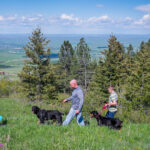Issue 13: Sustainable Outdoor Recreation and Tourism
By Emilene Ostlind
On a search for a place with “a combination of adventure, culture, and affordability,” Outside magazine recently named my hometown of Laramie, Wyoming, “the most affordable mountain town in the West.” The magazine highlighted Laramie’s access to mountain biking, skiing, hiking, and rock climbing along with microbreweries, film festivals, and a farmers market, all while maintaining a cost-of-living below the US average. I read this with a mixture of pride and dread, as no doubt did many other Laramigos. Yes, we know this town is a hidden gem with excellent outdoor amenities that lack the hype—and associated problems—plaguing more famous recreation destinations. And yet, we have already turned away from overflowing trailheads, encountered both human and dog poop at the base of favorite climbing crags, and watched as housing prices leaped skyward. Even before the publicity from Outside, it felt like Laramie might be the next of many western towns to be transformed by an outdoor recreation boom.
Communities across the West are racing to embrace outdoor recreation and tourism as an up-and-coming industry. This means figuring out how to reap economic and quality-of-life rewards while avoiding pitfalls such as trash, crowds, and too many seasonal, low-wage service jobs. “What would it look like to envision and work toward an outdoor recreation future where our communities are thriving?” asked the Ruckelshaus Institute (publisher of this magazine) in a statewide forum last year. At the forum, people from across Wyoming worked on how to balance economic, social, and environmental benefits of outdoor recreation against the impacts. Now, Western Confluence continues the conversation.
In this issue, professional journalists as well as students, staff, and faculty at the University of Wyoming explore outdoor recreation’s challenges and opportunities. As communities build new trails and businesses welcome visitors from afar, more people are experiencing the outdoors than ever before. But as usage grows, decision makers grapple with how to manage human waste, off-leash dogs, and housing crises. When outdoor recreators descend on a place that’s unprepared, managers scramble to accommodate, sometimes defending development plans to angry locals determined to protect their place from unwanted change. Addressing these challenges requires anticipating and planning for demand before it arrives. This might require reconsidering old systems in need of an update or taking creative approaches to steer outdoor recreation toward addressing local challenges.
These stories make me consider what Laramie might look like ten or twenty years from now. Will we be the next victim of the amenity trap, clogged with traffic and no longer affordable to anyone except the very wealthy? Or will we get ahead of the challenges and find solutions that welcome residents and visitors alike to our trails and mountains while creating a robust economy and protecting the qualities that make our town special today? As outdoor recreation shapes communities across the West, we hope this issue of Western Confluence will help towns and cities, parks and resource managers, understand both the value and perils and consider smart ways to prepare.


